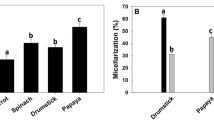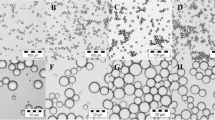Abstract
Purpose
To investigate the influence of olive (OO), groundnut (GNO), soybean (SBO), sunflower (SFO), rice bran (RBO), corn (CO), palm (PO) oil or mixed micelle (control) on absorption kinetics and bioavailability of lutein in lutein-deficient mice. Additional aim was to correlate the activity of intestinal triacylglycerol lipase with intestinal and plasma lutein levels.
Methods
After induction of lutein deficiency, mice (n = 165) were divided into eight groups (OO, SFO, GNO, RBO, PO, CO, SBO and control; n = 20/group) and the remaining (n = 5) were used as baseline (0 h). Groups were further divided into four subgroups (n = 5/subgroup) and were intubated with lutein (200 μM) dispersed in different vegetable oils. Plasma and tissue (intestine, liver and eyes), lutein, triglycerides, intestinal triacylglycerol lipases and fatty acid profile of plasma and tissues were measured at different time intervals.
Results
The percentage area under the curve value for plasma lutein in OO and GNO was higher by 41.8 and 5.1 %, while it was lower in other groups (18.2–53.3 %), when compared to control. Similarly, the percentage area under the curve for eye lutein in OO and GNO groups was higher by 35.2 and 4.8 %, whereas in other groups it was lower (5.4–69 %) than in control. Results show that olive oil facilitates the lutein absorption more compared to other vegetable oils, which may be due to the difference in fatty acid composition and higher activity of intestinal triacylglycerol lipase.
Conclusions
Dietary olive oil rich in oleic acid improves the bioavailability and accumulation of lutein in lutein-deficient mice by modifying the intestinal triacylglycerol lipase activity.




Similar content being viewed by others
References
Landrum JT, Bone RA (2001) Lutein, zeaxanthin, and macular pigment. Arch Biochem Biophys 385:28–40
Bone RA, Landrum JT, Mayne ST, Gomez CM, Tibor SE, Twaroska EE (2001) Macular pigment in donor eyes with and without AMD: a case-control study. Invest Ophthalmol Vis Sci 42:235–240
Mayne ST (2003) Antioxidant nutrients and chronic disease: use of biomarkers of exposure and oxidative stress status in epidemiologic research. J Nutr 133:933–940
Tapiero H, Townsend DM, Tew KD (2004) The role of carotenoids in the prevention of human pathologies. Biomed Pharmacother 58:100–110
Van het Hof KH, West CE, Weststrate JA, Hautvast JGA (2000) Dietary factors that affect the bioavailability of carotenoids. J Nutr 130:503–506
Borel P (2003) Factors affecting intestinal absorption of highly lipophilic food micro constituents (fat soluble vitamins, carotenoids and phytosterols). Clin Chem Lab Med 41:979–994
Faulks RM, Southon S (2005) Challenges to understanding and measuring carotenoid bioavailability. Biochim Biophy Acta 1740:95–100
Yonekura L, Nagao A (2007) Intestinal absorption of dietary carotenoids. Mol Nutr Food Res 51:107–115
Brown MJ, Ferruzzi MG, Nguyen ML, Cooper DA, Eldridge AL, Schwartz SJ, Whi WS (2004) Carotenoid bioavailability is higher from salads ingested with full-fat than with fat-reduced salad dressings as measured with electrochemical detection. Am J Clin Nutr 80:396–403
Clark RM, Yao L, She L, Furr HC (2000) A comparison of lycopene and astaxanthin absorption from corn oil and olive oil emulsions. Lipids 37:803–806
Lakshminarayana R, Raju M, Keshava Prakash MN, Baskaran V (2009) Phospholipids, oleic acid micelles and dietary olive oil influence the lutein absorption and activity of antioxidant enzymes in rats. Lipids 44:799–806
Nidhi B, Baskaran V (2011) Influence of vegetable oils on micellization of lutein in a simulated digestion model. J Am Oil Chem Soc 88:367–372
Lakshminarayana R, Raju M, Krishnakantha TP, Baskaran V (2005) Determination of major carotenoids in few Indian leafy vegetables by high-performance liquid chromatography. J Agric Food Chem 53:2838–2842
American Institute of Nutrition (1977) Report of the America Institute of Nutrition Ad Hoc Committee on standards for Nutritional studies. J Nutr 170:1340–1348
Baskaran V, Sugawara T, Nagao A (2003) Phospholipids affect the intestinal absorption of carotenoids in mice. Lipids 38:705–711
Lowry OH, Rosebrough NJ, Farr AL, Randall RJ (1951) Protein estimation with Folin phenol reagent. J Biol Chem 193:265–275
Folch J, Lees M, Sloane SGH (1957) A simple method for isolation and purification of total lipids from animal tissue. J Biol Chem 226:497–509
Fletcher MJ (1968) A colorimetric method for estimating serum triacylglycerol. Clin Chem Acta 22:303–307
Morrison MR, Smith M (1963) Preparation of fatty acids methyl esters and dimethyl acetyls from lipids with boron fluoride methanol. J Lipid Res 5:600–608
Yeum KM, Russell RM (2002) Carotenoid bioavailability and bioconversion. Ann Rev Nutr 22:483–504
Borne J, Nylander T, Khan A (2003) Vehicle formation and other structures in aqueous dispersions of monoolein and sodium oleate. J Colloid Interface Sci 257:310–320
Colle IJP, Buggenhou SV, Lemmen L, Loey AMV, Hendrickx ME (2012) The type and quantity of lipids present using digestion influence the in vitro bioaccessibility of lycopene from raw tomato pulp. Food Res Int 45:250–255
Unlu NZ, Bohn T, Clinton SK, Schwartz SJ (2005) Carotenoid absorption from salad and salsa by humans in enhanced by addition of avocado and avocado Oil. J Nutr 135:431–436
Mahan JT, Heda GD, Rao RH, Mansbach CM II (2001) The intestine expresses pancreatic triacylglycerol lipase: regulation by dietary lipid. Am J Physiol Gastrointest Liver Physiol 280:G1187–G1196
Coiffier E, Paris R, Lecerf J (1987) Effects of dietary SFA and PUFA fats on lipoprotein lipase and hepatic triglyceride lipase activity. Comp Biochem Physiol B 88:187–192
Birk RZ, Brannon PM (2004) Regulation of pancreatic lipase by dietary medium chain triacylglycerides in the weanling rat. Pediatric Res 55:921–926
Mamatha BS, Baskaran V (2011) Effect of micellar lipids, dietary fiber and β-carotene on lutein bioavailability in aged rats with lutein deficiency. Nutrition 27:960–966
Bender DA, Mayes PA (2006) Nutrition digestion and absorption. In: Murray RK, Granner DK, Rodwell VW (eds) Harper’s Illustrated Biochemistry, 27th edn. McGraw-Hill Company, Singapore, pp 482–488
Jackson KG, Robertson MD, Fielding BA, Frayn KN, Williams CM (2002) Olive oil increases the number of triacylglycerol-rich chylomicrons particles compared with other oils: an effect retained when a second standard meal is fed. Am J Clin Nutr 76:942–949
Van Greevenbroek MMJ, Van Meer G, Erkelens DW, De Bruin TWA (1996) Effects of saturated, mono- and polyunsaturated fatty acids on secretion of apoB containing lipoproteins by Caco-2 cells. Atherosclerosis 121:139–150
Hu X, Jandacek RJ, White WS (2000) Intestinal absorption of β-carotene ingested with a meal rich in sunflower oil or beef tallow: postprandial appearance in triacylglycerol-rich lipoproteins in women. Am J Clin Nutr 71:1170–1180
Hollander D, Ruble PE (1978) β-Carotene intestinal absorption: bile, fatty acids, pH and flow rate effects on transport. Am J Physiol 235:E686–E691
Acknowledgments
The authors thank the Director and Head of the Department of Biochemistry and Nutrition, CSIR-CFTRI, for their encouragement. Nidhi Bhatiwada and Mamatha BS acknowledge the award of Senior Research Fellowship by University Grants Commission and Indian Council of Medical Research, Government of India, New Delhi, India. We would like to thank Dr. NS Mahendrakar, Chief Editor, Journal of Food Science and Technology (Springer), for critically reviewing the manuscript for English language.
Conflict of interest
The authors declare no conflict of interest to disclose that could influence this work.
Author information
Authors and Affiliations
Corresponding author
Rights and permissions
About this article
Cite this article
Nidhi, B., Mamatha, B.S. & Baskaran, V. Olive oil improves the intestinal absorption and bioavailability of lutein in lutein-deficient mice. Eur J Nutr 53, 117–126 (2014). https://doi.org/10.1007/s00394-013-0507-9
Received:
Accepted:
Published:
Issue Date:
DOI: https://doi.org/10.1007/s00394-013-0507-9




